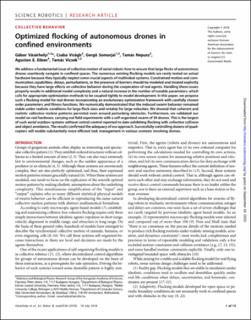| dc.contributor.author | Vásárhelyi, Gábor | |
| dc.contributor.author | Virágh, Csaba | |
| dc.contributor.author | Somorjai, Gergő | |
| dc.contributor.author | Nepusz, Tamás | |
| dc.contributor.author | Eiben, Agoston E. | |
| dc.contributor.author | Vicsek, Tamás | |
| dc.date.accessioned | 2023-09-28T11:44:34Z | |
| dc.date.available | 2023-09-28T11:44:34Z | |
| dc.date.created | 2019-02-20T13:53:44Z | |
| dc.date.issued | 2018 | |
| dc.identifier.citation | Science robotics. 2018, 3 (20), 1-13. | en_US |
| dc.identifier.issn | 2470-9476 | |
| dc.identifier.uri | https://hdl.handle.net/11250/3092721 | |
| dc.description.abstract | We address a fundamental issue of collective motion of aerial robots: how to ensure that large flocks of autonomous drones seamlessly navigate in confined spaces. The numerous existing flocking models are rarely tested on actual hardware because they typically neglect some crucial aspects of multirobot systems. Constrained motion and communication capabilities, delays, perturbations, or the presence of barriers should be modeled and treated explicitly because they have large effects on collective behavior during the cooperation of real agents. Handling these issues properly results in additional model complexity and a natural increase in the number of tunable parameters, which calls for appropriate optimization methods to be coupled tightly to model development. In this paper, we propose such a flocking model for real drones incorporating an evolutionary optimization framework with carefully chosen order parameters and fitness functions. We numerically demonstrated that the induced swarm behavior remained stable under realistic conditions for large flock sizes and notably for large velocities. We showed that coherent and realistic collective motion patterns persisted even around perturbing obstacles. Furthermore, we validated our model on real hardware, carrying out field experiments with a self-organized swarm of 30 drones. This is the largest of such aerial outdoor systems without central control reported to date exhibiting flocking with collective collision and object avoidance. The results confirmed the adequacy of our approach. Successfully controlling dozens of quadcopters will enable substantially more efficient task management in various contexts involving drones. | en_US |
| dc.language.iso | eng | en_US |
| dc.rights | Navngivelse-Ikkekommersiell 4.0 Internasjonal | * |
| dc.rights.uri | http://creativecommons.org/licenses/by-nc/4.0/deed.no | * |
| dc.title | Optimized flocking of autonomous drones in confined environments | en_US |
| dc.type | Peer reviewed | en_US |
| dc.type | Journal article | en_US |
| dc.description.version | publishedVersion | en_US |
| dc.source.pagenumber | 1-13 | en_US |
| dc.source.volume | 3 | en_US |
| dc.source.journal | Science robotics | en_US |
| dc.source.issue | 20 | en_US |
| dc.identifier.doi | 10.1126/scirobotics.aat3536 | |
| dc.identifier.cristin | 1679209 | |
| cristin.ispublished | true | |
| cristin.fulltext | original | |
| cristin.qualitycode | 1 | |

